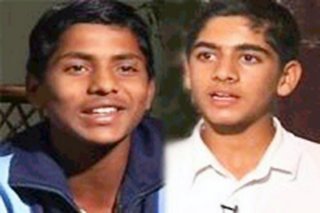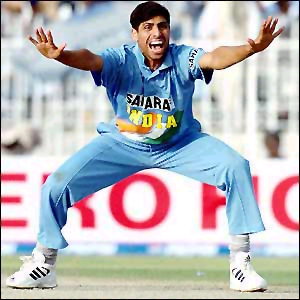What ails Indian cricket?Often defeat magnifies everything. Symptoms are looked for and spotted everywhere. But, the intricate linkages in cricket make identification of causality very difficult, writes S. Ram Mahesh.
A little over a year back, India's chances of winning an ODI series of note were compared by those inclined to the caustic cliche to the odds snowballs draw for surviving afternoons in Hell. Neither in the then distant 2007 World Cup nor in the seven-match series against Sri Lanka was India supposed to do well. Cue 13 months: things seemingly haven't changed. For, in the last six months, India has lost four of five games in West Indies, two of three in Malaysia, and two of three at home in the Champions Trophy. Had things been as cut and dried, had this phase extended 13 months instead of six, we could have cussed Greg Chappell, dissed Rahul Dravid, and revelled in what those with a little knowledge and a conviction, so strong it has to be baseless, do — smugly believe ourselves. Not that this isn't already being done in some quarters.
But, alas, it never is that simple. When Indian cricketer-turned-commentator Ravi Shastri wondered in his column whether this was the same limited-overs side that had warmed his heart earlier this year, he verbalised a discourse that has baffled many. This after all is the same team that had acquitted itself so spectacularly well in stern tests: a 6-1 shellacking of Sri Lanka — a side that had Jayasuriya, Sangakkara, Jayawardene (when he wasn't nipping out to get married), Atapattu, Vaas, and Muralitharan; a 2-2 draw against South Africa, always worthy; a 4-1 trouncing of Pakistan in Pakistan, where India has traditionally frozen when it hasn't destructed. While one-day wins over England, roughly the equivalent of mugging a sloshed Pom, rarely earn street cred, factor in the scarring Test loss in Mumbai that preceded it, and the 6-1 scoreline doesn't seem like anything to be sniffed at.
So what's happened? Why has a side that had shown off sparkling tactical ingenuity and Class-A nerves begun to falter? "Strategy was their strongest facet," says former national selector V. B. Chandrasekhar, part of the team management till recently. "They surprised other sides by being flexible and doing things differently. They knew exactly what they were doing. And that's where they are struggling now. They have made some glaring mistakes recently with the composition of the side, persisting with Pathan at three, not playing Kaif, carrying Sehwag. These are areas that need revisiting."
Chandrasekhar says a lack of awareness before the series in the Caribbean could have triggered inflection. "The side probably didn't take notice of the West Indies side transforming as a one-day team," he says. "They were close matches — we were on a roll, so logically we should have won them. But, we didn't."
Chandrasekhar goes on to make an interesting point — the focus on winning a Test series abroad, he says, detracted from the performance in the shorter form. "There was a lot of criticism after the Test loss against England. People complained we were only looking at the World Cup, that our focus was on the one-day game. That played a part."
COVER STORYWhat ails Indian cricket?
Often defeat magnifies everything. Symptoms are looked for and spotted everywhere. But, the intricate linkages in cricket make identification of causality very difficult, writes S. Ram Mahesh.
A little over a year back, India's chances of winning an ODI series of note were compared by those inclined to the caustic cliche to the odds snowballs draw for surviving afternoons in Hell. Neither in the then distant 2007 World Cup nor in the seven-match series against Sri Lanka was India supposed to do well. Cue 13 months: things seemingly haven't changed. For, in the last six months, India has lost four of five games in West Indies, two of three in Malaysia, and two of three at home in the Champions Trophy. Had things been as cut and dried, had this phase extended 13 months instead of six, we could have cussed Greg Chappell, dissed Rahul Dravid, and revelled in what those with a little knowledge and a conviction, so strong it has to be baseless, do — smugly believe ou

rselves. Not that this isn't already being done in some quarters.
But, alas, it never is that simple. When Indian cricketer-turned-commentator Ravi Shastri wondered in his column whether this was the same limited-overs side that had warmed his heart earlier this year, he verbalised a discourse that has baffled many. This after all is the same team that had acquitted itself so spectacularly well in stern tests: a 6-1 shellacking of Sri Lanka — a side that had Jayasuriya, Sangakkara, Jayawardene (when he wasn't nipping out to get married), Atapattu, Vaas, and Muralitharan; a 2-2 draw against South Africa, always worthy; a 4-1 trouncing of Pakistan in Pakistan, where India has traditionally frozen when it hasn't destructed. While one-day wins over England, roughly the equivalent of mugging a sloshed Pom, rarely earn street cred, factor in the scarring Test loss in Mumbai that preceded it, and the 6-1 scoreline doesn't seem like anything to be sniffed at.
So what's happened? Why has a side that had shown off sparkling tactical ingenuity and Class-A nerves begun to falter? "Strategy was their strongest facet," says former national selector V. B. Chandrasekhar, part of the team management till recently. "They surprised other sides by being flexible and doing things differently. They knew exactly what they were doing. And that's where they are struggling now. They have made some glaring mistakes recently with the composition of the side, persisting with Pathan at three, not playing Kaif, carrying Sehwag. These are areas that need revisiting."
Chandrasekhar says a lack of awareness before the series in the Caribbean could have triggered inflection. "The side probably didn't take notice of the West Indies side transforming as a one-day team," he says. "They were close matches — we were on a roll, so logically we should have won them. But, we didn't."
Chandrasekhar goes on to make an interesting point — the focus on winning a Test series abroad, he says, detracted from the performance in the shorter form. "There was a lot of criticism after the Test loss against England. People complained we were only looking at the World Cup, that our focus was on the one-day game. That played a part."
Perhaps most worryingly Chandrasekhar lets on that there is "a lack of flow of information" within the team. This is alarming, for, when Dravid and Chappell said that their strategy was based on cricketing logic and discussions others weren't privy to and hence couldn't fully comprehend they had a point. Most trenchant critics either have a surprisingly poor grasp of cricket or an axe to grind; some beyond redemption have both.
Consequently a lot of criticism is built on shaky, dubious foundations. But, if an insider, who has often sprung to his side's defence, questions the flow of information — the most crucial ingredient in preparation — something must be amiss.
Often defeat magnifies everything. Symptoms are looked for and spotted everywhere. But, the intricate linkages in cricket make identification of causality very difficult. Statistics will show that India since the West Indies tour has averaged fewer runs per wicket and scored at a slower rate per over when batting, and has been more expensive per wicket when bowling than when it was busy stacking up a record 17 consecutive successful chases.
The numbers will show that Dravid, Yuvraj, Dhoni, and Pathan — agents of change — have dropped off their high levels, that Sehwag's last ODI hundred was in April 2005. But, they don't illustrate entirely how Bravo conned Yuvraj — a run short of making it 18 chases — with one squeezed out slower, thus starting the decline, or how Sehwag's troubles with the incoming ball has been exacerbated by shooters that have crept along the turf, or how Harbhajan was a moment of prudence away from burying Australia in Malaysia when he let Haddin off.
It's just as difficult to monitor changes in levels of skill. During the glory days, Yuvraj, Pathan, Dhoni, and Raina improved their skills noticeably. Pathan has since had problems with the rhythm of his run-up and hence his delivery stride — both of which seemed to pick up against England in the Champions Trophy. For the others it's been a case of swift punishment for an early mistake, a common enough occurrence during the start of most innings. This in turn has set up a cycle of dwindling confidence and insecure selection of stroke, each feeding off the other.
Ajit Agarkar's metamorphosis in the Caribbean and Harbhajan's turn to parsimony notwithstanding, India's bowling — while out-performing the batting — has lacked a strong, wise leader. The inclusion of Anil Kumble is as much for his leg-spin — an option of attack allied with Harbhajan's off-spin during the middle overs — as it is for his considerable bowling brain. Munaf Patel has come along magnificently in terms of control; but as he showed against Australia, he still is a few dozen matches short of being the finished ODI product. R. P. Singh, who sent Chappell and Ian Frazer into raptures of delight during one net session by befuddling Dravid no less without perceptible change in wrist action, went for 29 in the four overs he bowled in the Champions Trophy. He shouldn't be allowed to slip through the system. Sreesanth is always worth a punt. He, like Munaf, raises his game against the best batsmen.
The re-introduction of Zaheer Khan should give the fast-medium department just the shot of experience it needs. But, only if he is able to convince those that matter about his commitment and work ethic. Former medium-pacer Venkatesh Prasad, who by many accounts is doing a fine job coaching, believes a dedicated bowling coach can help significantly. "Greg Chappell is head coach, but he can't be everywhere," says Prasad. "Every department is specialised. That's where a bowling coach comes in. We've had foreign coac

hes for six years now — this is the right time to get an Indian involved so he can work with Chappell and carry it forward."
The standards of fielding raise serious concern. Despite a lot of targeted work from the coaching staff — getting the players to twitch their hips to generate power on throws for instance — the ground fielding has shown a tendency to break down under duress since the series in the Caribbean.
The injury to Yuvraj, the failing form of Raina, and the mismanagement of Kaif have weakened a top-notch offside dragnet. Tendulkar's throws from the deep are suspect; Dravid's catching at slip schizophrenic, and the mobility of others, save Sreesanth and Agarkar, plain gauche. Nowhere has the decline been more evident than in the thinking. Dravid's captaincy in recent times has fallen short of the admirable creativity and assurance he brought to the job earlier in the year.
Perhaps it's splitting hairs, for he is only as good as his team — astute moves can be made to look foolish by poor execution. But to say nothing is cast in stone, and then proceed to bat Pathan at three in four of the last five matches he has played, when Dhoni — who averages 64.25 at three — has batted at that spot just once in the last 11 games is a bit rich.
Dravid, however, has a resilience of mind few cricketers approach. He will need all of it, for, as Chandrsekhar says, "imagine a scenario where we lose badly in South Africa. It will be very tough to pick ourselves up from there. There will be lots of calls for heads (to roll)."








